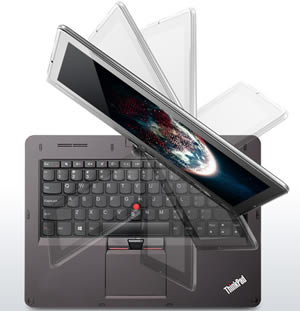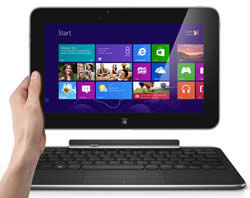Difference between Lenovo Thinkpad Twist and Dell XPS 10 Tablet
Key difference: The unique aspect of Lenovo Thinkpad Twist is that it is a convertible laptop with the ability to twist its screen and fold back. This allows the device to take up four design modes. This includes Laptop Mode, Tablet Mode, Tent Mode and finally, Stand Mode. The Lenovo Thinkpad Twist features a 12.5 HD IPS display with Touch Senso of Magnesium Alloy Construction with Corning Gorilla Glass. It is powered by Intel Core, and is actually available in three variants. The Dell XPS 10 is a 10.1-inch tablet that comes with a keyboard Dock to make it into a laptop. The screen is an HD Display capacitive multi-touch screen, with 1366 x 768 pixels and an approximately 155 ppi pixel density. The sleek tablet has a metal chassis and has a rubber back for better gripping.

Lenovo Group Limited is a Chinese multinational with its operational headquarters in Morrisville, North Carolina. The company provides computer hardware and electronics, including personal computers, tablet computers, mobile phones, workstations, servers, electronic storage devices, IT management software and smart televisions. Among other things, the company is especially known for its computers, especially the ThinkPad and IdeaPad line of notebook computers.
The Lenovo Thinkpad Twist is inline with its ThinkPad series, which is known for its durability, long life and easy availability of replacement parts. In fact, laptops in Lenovo Thinkpad series are currently the only laptops certified for use on the International Space Station.
The unique feature of Lenovo Thinkpad Twist is that its screen and CPU is attached with a single twistable hinge that gives the device the ability to twist its screen and/ fold back completely. This feature gives the device versatility and allowing the user to use the device as either a laptop or a tablet. It also allows the device to take up to four design modes: Laptop Mode, Tablet Mode, Tent Mode and finally, Stand Mode. Hence, the device is effectively two-in-one, a tablet and a laptop.
The Lenovo Thinkpad Twist features a 12.5 HD IPS display with Touch Sensor of Magnesium Alloy Construction with Corning Gorilla Glass. It is powered by Intel Core, and is actually available in three variants, Intel Core i3/ i5/ i7. It has up to 8 GB RAM which varies as per the processor. The Thinkpad Twist runs Microsoft 8 as its OS, and has either 320 GB or 500 GB of hard disk memory, as well as 128 GB of SSD or solid-state drive. The SSD works to improve application load times and system boot times.
The Lenovo Thinkpad Twist is a follow-up to the company’s popular IdeaPad Yoga line. Other than provide the durability of a ThinkPad over the IdeaPad, it also aimed to improve on a feature of the IdeaPad Yoga series. The IdeaPad Yoga series are also convertible laptops, however in order to get to the tablet mode, the screen folds back, which leaves the keyboard exposed on the back of the tablet. This makes holding the tablet, a little awkward. The ability of the Lenovo Thinkpad Twist to twist its screen 180 deg before folding back addresses this issue as the twist allows the screen to cover the keyboard. However, the device has been criticized as being too heavy to be used comfortably as a tablet.
Dell is a popular company that is well-known for its customizable computers. It allowed people to build laptops and desktops from scratch, adding only components they need and paying only for those components. It has become a popular name in laptops, but has yet to launch itself in the tablet market. In response to the growing market for tablets the company has launched Dell Streak, which did not manage to garner much positive response for the company. Dell announced in August that is launching its newest table the Dell XPS 10 in October 2012.
 The Dell XPS 10 is a 10.1-inch tablet that comes with a keyboard Dock to make it into a laptop. The tablet serves the purpose of fulfilling the need for the tablet on the go and a laptop for some serious professional work. The company has launched the tablet on the Windows RT OS, which have not been able to draw in many customers. According to every review website, the company has not been doing that well in sales of tablets due to the Windows OS. However, the design of this tablet and its features should bring in loyal Dell fans to the product. The screen is an HD Display capacitive multi-touch screen, with 1366 x 768 pixels and an approximately 155 ppi pixel density, which is not the best resolution available on the tablets, but it wasn’t that bad when viewing the tablet. The sleek tablet has a metal chassis and has a rubber back for better gripping. The tablet itself is quite sleek and lightweight making it easier to carry. The screen is small though because of the black bezel on the screen. The screen is made using Asahi Dragontrail high strength glass for durability.
The Dell XPS 10 is a 10.1-inch tablet that comes with a keyboard Dock to make it into a laptop. The tablet serves the purpose of fulfilling the need for the tablet on the go and a laptop for some serious professional work. The company has launched the tablet on the Windows RT OS, which have not been able to draw in many customers. According to every review website, the company has not been doing that well in sales of tablets due to the Windows OS. However, the design of this tablet and its features should bring in loyal Dell fans to the product. The screen is an HD Display capacitive multi-touch screen, with 1366 x 768 pixels and an approximately 155 ppi pixel density, which is not the best resolution available on the tablets, but it wasn’t that bad when viewing the tablet. The sleek tablet has a metal chassis and has a rubber back for better gripping. The tablet itself is quite sleek and lightweight making it easier to carry. The screen is small though because of the black bezel on the screen. The screen is made using Asahi Dragontrail high strength glass for durability.
The device has a SIM card slot for optional 2G, 3G and 4G capability, if required. The tablet comes with 32/64 GB Flash Storage and also has a microSD slot that allows users to upgrade the internal storage capacity by 64 GB. The system is powered by a 1.5GHz Dual-core processor and has a Qualcomm Snapdragon S4 GPU. The device provides a 2GB RAM, which allows serious multi-tasking capabilities. The tablet provides Bluetooth, Wi-Fi and USB capability. The dock (keyboard), when attached provides two extra USB 2.0 slots on either side. The keyboard is also sleek and thin with dedicated Windows soft keys and trackpad. Both the tablet and the keyboard have a charging port. This is because when docked, the charging port on the bottom of the device gets covered by the keyboard and the user can still charge using the secondary port. The tablet has a 5MP rear camera with autofocus ability, but it lacks a flash. This results in distorted images in dark lighting. The camera also has weak video performance and the sharpness must be constantly updated during recording. The device also houses a 2MP secondary camera that is decent for snapshots and video conferencing.
The device houses a non-removable 28Wh 2-cell lithium-ion battery that provides 10 hours, 30 minutes of multimedia time, while the dock has an additional 27 Wh battery that extends battery life to 18 hours, 18 minutes. The device also fared decently during gaming tests. All of the devices are available Office Home & Student 2013 RT that can be changed and customized on the company’s website before shipping. The Windows OS only allows downloading apps from the Windows Stores, which does not have that many choices in apps. The tablet has been designed to be used as a personal tablet as well as a professional laptop, eliminating the need for spending on both.
The information for the detailed table about the two devices has been taken from the Lenovo website, the Dell website, trustedreviews.com, notebookcheck.net, and GSMArena.com.
|
|
Lenovo Thinkpad Twist |
Dell XPS 10 Tablet |
|
Launch Date |
Q4 2012 |
October 2012 |
|
Company |
Lenovo |
Dell |
|
Size |
313mm x 236mm x 20mm (12.3" x 9.3" x 0.8") |
Tab: 9.2 x 274.7 x 177.3mm Tab + Dock: 23.91 (hinge end) x 274.7 x 177.3mm |
|
Display |
12.5" HD IPS display with Touch Sensor, 350 nit |
10.1" HD Display capacitive multi-touch screen |
|
Screen |
1366 x 768 pixels (~125 ppi pixel density) |
1366x768 pixels (~155 ppi pixel density) |
|
Protection |
Magnesium Alloy Construction With Corning Gorilla Glass |
Edge-to-edge Asahi Dragontrail high strength glass |
|
Weight |
1.58 kg (3.48 lbs) |
Tab: Wi-Fi: 635 grams Tab: LTE: 645 grams Tab + Dock: 1310 grams |
|
2G Network |
- |
GSM 850 / 900 / 1800 / 1900 (optional) |
|
3G Network |
- |
HSDPA (optional) |
|
4G Network |
- |
LTE (optional) |
|
GUI |
Windows 8 |
Windows |
|
CPU speed |
1.8 GHz - 3.0 GHz (Depending on processor) |
1.5GHz Dual-Core processor |
|
GPU |
Intel HD Graphics 4000 |
Adreno 225 |
|
OS |
Windows 8 64 / Windows 8 Pro 64 |
Windows RT |
|
Chipset / Processor |
Intel Core i7 – 3517U (3.0 GHz, 4MB L3, 1600 MHz FSB) Intel Core i5 – 3317U (2.60 GHz, 3MB L3, 1600 MHz FSB) Intel Core i3 – 3217U (1.8 GHz, 3MB L3, 1600 MHz FSB) |
Qualcomm Snapdragon S4 |
|
RAM |
Up to 8GB DDR3 |
2 GB |
|
SIM Size |
- |
micro-SIM |
|
Internal Memory |
HDD: 320GB/500GB (7200RPM) SDD: 128GB |
32/64 GB Flash Storage |
|
Expandable Memory |
- |
Up to 64 GB |
|
Sensors |
- |
Accel, gyro, compass, AGPS (with LTE configurations), ALS, sensor fusion |
|
Connectivity |
2 USB 3.0 ports, 1 RJ45, 1 4-in-1 slot, 1 Mini-DP, 1 Mini-HDMI, Gigabit Ethernet |
USB, HDMI, Bluetooth (optional 2G, 3G and 4G network) |
|
Data |
- |
USB, HDMI, Bluetooth, Wi-Fi, with optional mobile connectivity. |
|
Speed |
- |
1510.0 MHz HSPA+/LTE (optional) |
|
WLAN |
802.11 b/g/n wireless |
Dual-band Wi-Fi (802.11a/b/g/n) |
|
Bluetooth |
Bluetooth v4.0 |
Bluetooth v4.0 |
|
USB |
USB 3.0 |
Micro-USB |
|
Primary Camera |
720p HD Webcam |
5MP rear camera |
|
Secondary Camera |
- |
2MP front camera |
|
Video |
- |
720p@30fps |
|
Camera Features |
- |
Autofocus |
|
Sound Enhancement |
Stereo speakers, Built-in dual array microphone (combo jack), Dolby Home Theatre v4 |
None |
|
Audio supported formats |
Dependent on media player |
MP3/WAV/eAAC+ player |
|
Video supported formats |
Dependent on media player |
MP4/H.264/H.263 player |
|
Battery Capacity |
- |
Tab: Non-removable 28Wh 2-Cell Lithium Ion battery |
|
Stand-by / Battery Life |
7 hours (with Battery Safeguard Hardware Authentication) |
- |
|
Talk time |
- |
Tab: 10 hours, 30 minutes Dock: 18 hours, 18 minutes |
|
Available Colors |
Carbon Black |
Black/Steel |
|
Messaging |
- |
Email, Push Email, IM |
|
Browser |
HTML - |
HTML5 |
|
Radio |
No |
No |
|
GPS |
No |
GPS with A-GPS support (with LTE/HSPA+ configs) |
|
Java |
No |
No |
|
Additional Features |
|
|
Image Courtesy: lenovo.com, dell.com









Comments
After examine a couple of of the weblog posts in your web site now, and I truly like your way of blogging. I bookmarked it to my bookmark web site list and shall be checking back soon. Pls check out my site as nicely and let me know what you think.
louis vuitton b...
Sun, 08/10/2014 - 20:46
Add new comment